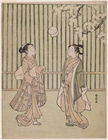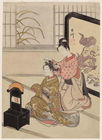Home > Suzuki Harunobu
Suzuki Harunobu

Suzuki Harunobu
Young Couple Playing Football
Suzuki Harunobu
The Jewel River of Bush Clover a Famous Place in Omi Province (Hagi no Tamagawa Omi no meisho Toshiyori) from an untitled series of Six Jewel rivers (Mu Tamagawa)
Suzuki Harunobu
The Heron Maiden (Sagi musume)
Suzuki Harunobu
Night Rain at Karasaki (Karasaki yau) first state from the series Eight Views of Omi (Omi hakkei no uchi)
Suzuki Harunobu
Girls Playing the Game of Ken
Suzuki Harunobu
The Peasant Girls Poem (Shizunome no uta)
Suzuki Harunobu
Autumn Moon of the Mirror Stand from the series Eight Views of the Parlor (Zashiki hakkei)
Suzuki Harunobu
Young Woman Riding a Turtle (Parody of the Story of Urashima Taro) second state
Suzuki Harunobu
A Young Woman Smoking and Daruma Emerging from a Hanging Scroll
Suzuki Harunobu
Two Men Looking through Window Lattice at a Courtesan Writing a Letter
Harunobu Suzuki (Harunobu Suzuki, 10th year of Kyoho <1725>?-June 15, 1770 <7th July 1770>) is an ukiyo-e artist in the middle of the Edo period. It gained popularity for its slender, pretty, and delicate facial expressions, and played a decisive role in the birth of the woodblock multicolored nishiki-e that comes to mind when it comes to ukiyo-e, and had a great influence on the development of ukiyo-e later.
It is said that he went to Kyoto and learned from Nishikawa Sukenobu, and later lived in Edo. Or it is said to be a student of Shigenaga Nishimura. His surname is Hozumi, and later Suzuki. Known as Jirobei. Also known as Choeiken and Ancient People. It is believed that he was the owner (landlord) of Edo Kanda Shirakabe Town (currently Kajicho (Chiyoda Ward)) and was relatively wealthy. Hiraga Gennai lives in the neighborhood, and he is said to have been close friends and devised Nishiki-e together. The actor's picture "Soga Goro of Ichimura Kamezo and Mihoya Shiro of Bando Sanpachi" based on the play performed in March 1760 is said to be the first work, and he will die after this. He was active as an ukiyo-e artist for 10 years. In the early days, Benizuri-e actors were also known. During the Horeki year, in addition to such actor paintings and bijin-ga, he produced the classic Benizuri-e and water paintings. Currently, more than 30 actor paintings and more than 30 water paintings are known.
